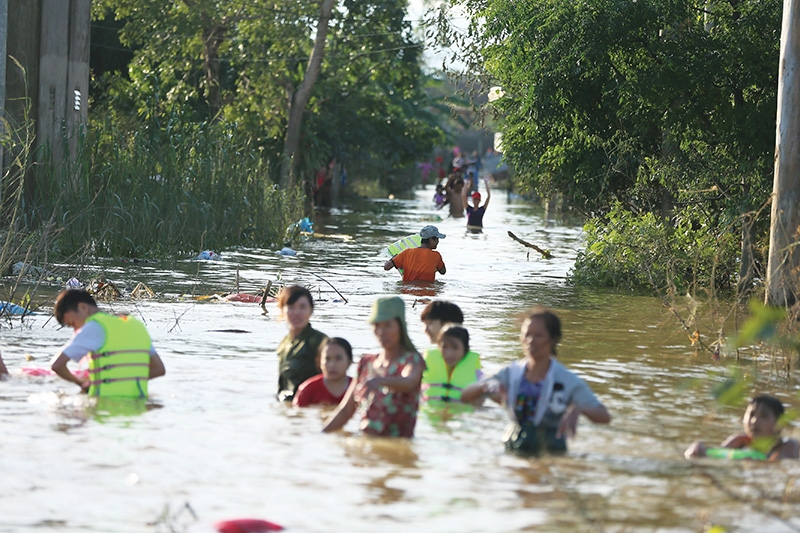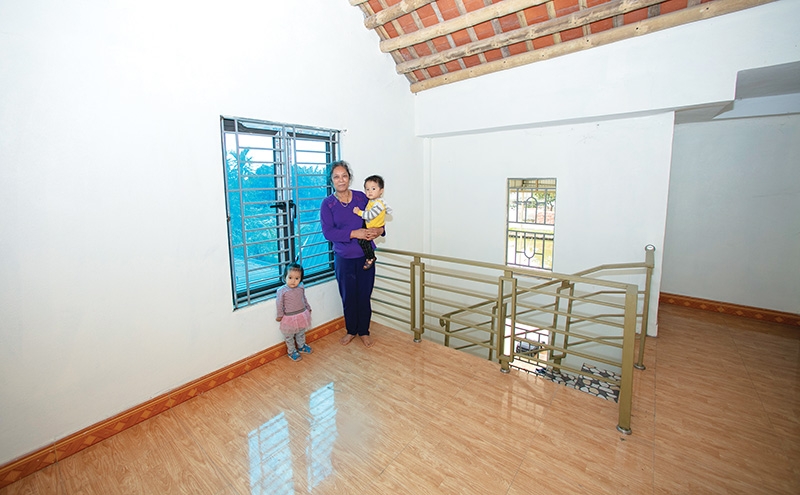
 Tin tức về dự án
Tin tức về dự án
Đăng trên Báo Đầu Tư ngày 06/11/2020
Hơn 3.200 ngôi nhà chống chịu bão, lụt đã trở thành nơi trú ẩn an toàn cho hàng nghìn người dân ở 5 tỉnh ven biển miền Trung sau đợt mưa lũ lịch sử từ ảnh hưởng của nhiều trận bão liên tiếp, đặc biệt gần đây nhất là bão Molave.

Just a few hours prior to the October 28 arrival of the strongest storm seen in Vietnam in the last 20 years, Bui Thi Chin’s family in Binh Son district of the central province of Quang Ngai was completing the final stages of preparation for the incoming threat.
For the families of millions of people in other central coastal provinces, storms and floods have become a familiar part of their lives for many years. However, 2020 has brought disaster over disaster for the central region with some of the strongest storms ever experienced in recent weeks, on top of the difficulties that the global health crisis has brought in recent months.
Chin said that when she learned of storm Molave’s approach to the mainland, she was so worried and could not sleep for several nights. It was projected that the eye of the storm would most likely be located over Quang Ngai. “The wind began to blow so fiercely from the afternoon. However, my family had promptly reinforced my home’s resistance and moved our belongings to the attic, so I feel safer. My husband and I will also be in the attic for the next few days because heavy rains can lead to flooding,” said Chin.
The house of Chin’s family is one of more than 3,200 storm- and flood-resilient houses constructed in the central coastal provinces of Thanh Hoa, Quang Binh, Thua Thien-Hue, Quang Nam, and Quang Ngai jointly funded by the Green Climate Fund, the Vietnamese government, and the United Nations Development Programme (UNDP). The partnership aims to improve the resilience of vulnerable coastal communities to climate change-related impacts in the central Vietnam.
Along with Quang Ngai, Quang Binh, Quang Tri, and Thua Thien-Hue have also been battered by persistent torrential rains, causing widespread flooding and landslides. Since October 5, prior to Molave’s arrival, nearly 150 people have been killed or gone missing, more than 270,000 houses have been flooded, over 37,500 homes have been damaged, and around 57,000 people have been evacuated to temporary shelters, as reported by the UNDP and the Ministry of Agriculture and Rural Development’s Vietnam Disaster Management Authority in Quang Binh, Quang Tri, and Thua Thien-Hue.

Providing shelter
During the flooding, the storm- and flood-resilient houses like Chin’s begin to take effect in ensuring the safety of people’s lives and property. In the severely-flooded Thua Thien-Hue, nearly 600 such homes have withstood the recent relentless weather, including during historically high flooding over the past few weeks.
Meanwhile, in Quang Binh, many people have lost almost all of their household possessions to the floodwaters, but there are also those who are more fortunate because the storm- and flood-resilient houses are not only a safe shelter, but also act as food storage facilities.
Nguyen Van Duoc’s family in Son Thuy commune of Le Thuy district is one of the households in this case. He said his house is a meaningful asset of his life, and he decided to have it built after receiving advice and support from the UNDP as well as the local government.
Elsewhere Duong Thi Trinh, residing in Le Thuy commune in Quang Binh, also shared her gratefulness to own a solid house because it not only becomes a shelter for her family but has also been a common home for many neighbouring families in recent flooding days. “We are fortunate to have a cosy and safe place to live,” said Trinh.
According to Dao Xuan Lai, UNDP assistant resident representative, and head of Climate Change and Environment, storm- and flood-resilient houses must ensure criteria such as being resistant to both storms and floods and having flood-proof flooring, while construction cost is kept low.
“A qualified storm- and flood-resilient house must have a foundation made of reinforced concrete, brick, or stone, columns and beams made of reinforced concrete, wall built with brick or stone, flood-proof floors, and a roof that can withstand wind speeds about 100km per hour,” Lai explained. The foundation is relatively high compared to normal, and the flood-proof floor must be at least 1.5m above the 6-metre flood level of a historical flood which occurred in 1999. Flood-proof floors (Mezzanines) should have a minimum area of 10 square metres and are made of reinforced concrete or solid wood with safety floor railings made of sturdy iron, steel, or wood.
Flood-proof futures
The resilience of these important homes after major floods has illustrated the outstanding advantages of the buildings. Particularly, for households with difficult circumstances – the main beneficiaries of the project – such housing helps protects lives and assets, quickly stabilises livelihoods, contributes to building a safe community, and proactively mitigates the impacts of climate change.
As a result, there are calls for the model of storm- and flood-resilient houses to be replicated and scaled up in central coastal provinces that are severely damaged by natural disasters.
Nguyen Van Thuc, Chairman of the People’s Committee of Son Thuy commune in Quang Binh said, “In addition to poor and disadvantaged households, we should expand the scope to support near-poor households in order to build resilient houses in extremely difficult areas.”
The suggestion is already part of the plan for the UNDP project to replicate resilient housing models. According to Caitlin Wiesen, UNDP resident representative in Vietnam, it has mobilised $100,000 from its emergency resources to assist the government and vulnerable and flood-affected people in the central region through building such homes.
In addition to 600 storm- and flood-resilient houses in Thua Thien-Hue, more than 1,000 houses in Quang Binh and Quang Nam and thousands more in localities of Quang Ngai and Thanh Hoa have been gradually appearing since 2017 and will continue to be built until 2021. More than other 800 resilient houses are planned to be built in the next year.
“UNDP will continue to support vulnerable and flood-affected people by building resilient houses,” reaffirmed Wiesen.
A day after storm Molave directly ripped through Quang Ngai with wind speeds reaching 100km per hour, causing many houses to have their roofs blown off and large trees uprooted, Bui Thi Chin informed that her whole family was safe there, and her property had not suffered much damage. She and her husband felt safer than before, and the house did its job despite heavy rain and strong winds outside.
Chin said emotionally, “Vietnamese people have a saying about settling down and thriving. Hopefully many people in Quang Ngai from my hometown as well as people in other central provinces will have warm, safe houses like ours so that floods and storms will no longer become an obsession and bring heavy losses.”
As fact, in Vietnam, there are already many varying designs of resilient houses such as floating homes, and buildings with concrete pillars that are being constructed in several provinces in the central and south of the country.
“Most of the houses built under this programme are very sturdy and beyond the standard requirements. They are very durable,” said Nguyen Manh Khoi, deputy director of the Housing and Real Estate Market Management Agency under the Ministry of Construction.
These houses have not only been built through contributions from the UNDP initiative but also from policy bank loans and support from international donors, commune resources, and other social resources.
“We have developed a project to build 4,000 resilient houses for poor people who are vulnerable to disasters. As we have been implementing this project, we received much appreciation from the locals, who were very excited. Currently, the provinces are implementing the project, and while its budget is not particularly large, we think that it has had a real practical effect so far,” said Tran Quang Hoai, director general of the Vietnam Disaster Management Authority.
 Tin mới
Tin mới
- Lồng ghép nội dung Phòng, chống thiên tai vào quy hoạch, kế hoạch phát triển ngành, kinh tế - xã hội tại địa phương (07/04/2022)
- Thúc đẩy mạng lưới doanh nghiệp tiên phong và chủ động trong phòng chống thiên tai, ứng phó biến đổi khí hậu và dịch bệnh (15/10/2021)
- Lễ phát động cuộc thi “Tìm kiếm sáng tạo truyền thông về giảm thiểu tác động của thiên tai và biến đổi khí hậu” (12/10/2021)